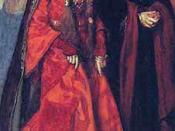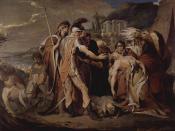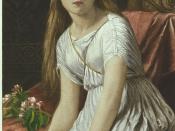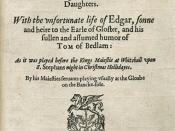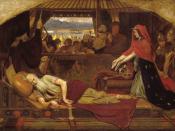King Lear, written by William Shakespeare between 1603 and 1606, is a play set in mythical England. The play has been enjoyed and studied for centuries and will continue to be enjoyed for centuries to come. King Lear is Shakespeare's tragic tale that features a plot and a sub-plot. King Lear story and Gloucester's story are in fact the same story; however, they are told in two different ways. Both stories share identical moral "ÃÂ that we do not always judge our children according to their merit, but by rather the actions they perform, and when we misjudge those closest to us in this way, disaster is the inevitable result. King Lear is an immensely difficult play to understand; however, our critical analyses help foster a greater understanding of the play as a whole. Out of this play we, as a group, have chosen to summarize the play, pick a particular scene to further analyze and describe the mise en scene, particularly, casting, costuming, and lighting, and of the three elements we will justify our choices.
To lend further credence to our choices, we have chosen to use a modern day cast with modern day casting.
To summarize the first act, King Lear, in his old age, decides to divide his kingdom between his three daughters, Goneril, Regan, and Cordelia. He creates a test of love so that he can decide which daughter loves him the most. Consequently, whoever loves him the most gets the most land; however, secretly he wishes Cordelia to get a majority of the land. Goneril and Regan shower him with love but it is obviously contrived insincerity that Lear apparently enjoys. Cordelia simply tells the King she loves him, " no more nor less." This angers the King. In a fit of blind rage he splits up the kingdom between Regan and Goneril and leaves Cordelia with nothing. The Duke of Burgundy decides he does not want her because she no longer has any value. The King of France decides to take her instead. Lear in his fit of rage banishes Kent from the kingdom. Lear keeps 100 knights to himself. Then the subplot is introduced -- the Gloucester subplot. Gloucester has an illegitimate son named Edmund and a real son named Edgar. Edmund is upset because he wants to be in charge so he devises a big plan to run Edgar away from the land by giving Gloucester a letter saying that Edgar was trying to kill him so that Edgar could take over the land. Edmund manipulates Edgar into running away. Kent shaves off his beard, disguising himself, so that maybe he can talk some sense into Lear. The Fool is introduced. The Fool is an interesting character, his speech is laced with puns and riddles, which, ironically, makes the king look like a fool. Lear begins to see that Goneril is not the good little daughter that he thought that she was. Lear sends Kent as a messenger to Gloucester.
In the second act, the sub-plot is further developed. Edmund has a plot to get rid of his brother. Edgar, in Gloucester's eyes, begins to fall apart. Edmund wounds himself and tells Gloucester that Edgar did it, and Edgar must now run away. Kent arrives to Gloucester's. Regan and Cornwall are there, too. Cornwall and Regan put Kent into the stocks. Next Edgar transforms himself into a beggar-like character -- "Poor Tom." Lear comes and finds that Kent was put into the stocks. He is extremely upset because this is considered to be disrespectful. Lear asks Regan if he can stay with her. He doesn't want to stay with Regan anymore, but he finds that Regan is perhaps more evil than her sister. She doesn't want him to live with her. Lear rushes out into the storm in his "madness." The third act further develops the story. Kent tries to get help from Cordelia. He finds a gentleman and he gives him a ring to give to Cordelia. The Fool and Kent accompany Lear out in the storm. Edgar as "Poor Tom" also accompanies Lear in the storm. Gloucester goes and tries to get Lear out of the storm, but he refuses and complains about how much his daughters do not love him. Gloucester comes and says that he has heard about a plot to kill the king. He tells this to Kent. Regan, Goneril, and Cornwall find out that Gloucester is trying to save Lear. Cornwall stabs out Gloucester's eyes for punishment.
The fourth act, which contains the scene we have chosen to analysis in-depth, contains several interesting scenes, and is when King Lear truly succumbs to madness. Gloucester is taken away and led by an Old Man to Edgar acting as Poor Tom. Edgar leads his father to Dover. We are told how Edmund and Goneril had been becoming good friends. Albany begins to realize how foolish his wife really is. The gentleman gets back to Kent and he tells Kent that he told Cordelia the news of her father, Lear. Gloucester wants to die, and he tells "Poor Tom" to take him to a cliff so that he can kill himself. Edgar won't let him kill himself though. Lear enters in a "mad state". Oswald shows up to kill Gloucester. Edgar intervenes and kills Oswald. Edgar tells his father about his secret identity. Cordelia is reunited with her father.
In the final act, we find out that Regan and Edmund are, also, becoming very friendly. Cordelia and Lear are taken as prisoners. The Duke of Albany confronts Edmund and they end up dueling. Edgar appears and wounds Edmund. Edmund confesses about everything then Goneril poisons Regan and kills herself. Lear comes in with the body of his beloved daughter, Cordelia. Lear finds out that the Fool is dead. King Lear dies. Edgar is given the rule and once again orders is returned to the country.
The scene we, as a group, chose to scrutinize with a closer eye is Act 4, scene 2. The scene is filled with many interesting events, and we feel is representative of the overall betrayal and deceit that permeates the entire play. Goneril and Edmund seem to have a desire to become intimate while Albany is struck with an epiphany that his wife is truly evil, and she has always had ulterior motives. Albany and Goneril have become entangled in a quite interesting argument that has seemly divided the two. The argument is only interrupted when a messenger appears to deliver news that Cornwall is dead. Interestingly, Albany is more concerned with Edmunds betrayal of Gloucester, and finally declares that he is on the side of the King.
We found the scene to be of extreme interest because of the overwhelming emotional exchange between characters in the scene; furthermore, we decided to develop mise-en-scene with a focus on lighting, costume, and especially the particular character one would cast in a modern day version of King Lear. Lighting helps set the macabre tone of this scene. The costumes develop characteristics of the cast. And, above all, the cast itself will overall affect the meaning of this play.
The play compiles a majority of dark emotions with a careful use of low-key illumination, a variety of shadows, and tumultuous weather. As the scene begins, Goneril and Edmund enter Albany's castle we see a sudden wash of dramatically white lights coupled with heavy thunder and lightening. We can hear the thunder reverberate throughout the palace as it flows through the blackened sky. As Oswald welcomes the two, a candle opera is in the corner vainly attempting to brighten the hallway. The light is dim yet bright enough to for the audience to see the facial expression as Goneril and Edmund exploit glances of sexual tension. The mood has been set through the use of limited light and eerie shadows. As the scene progresses, the light becomes increasingly brighter as the bitter emotion between Goneril and Albany continue to grow. The apex of the hatred is reached when the messenger enters and presents the letter, stating the death of the Duke of Cornwall and Gloucester blindness, with this horror the lights suddenly dim. The room slowly returns to normal light yet adding certain vividness. And, the mood is suddenly solemn. The lighting adds to the mood; however, lighting coupled with costume design sets the true tone.
Costuming is an extremely important role in a play. The audience should be able to differentiate the good guy from bad guy by what he or she wears; it defines a character without dialogue. The characters in the scene are Goneril, Oswald, Edmund, Albany, and the Messenger, and we designed the costumes to fit our modern day interpreted of the scene; hence, the costumes styled from current day fashions and brands.
Goneril, King Lears, eldest daughter is quite a dubious characters. Thus, she must be dressed to fit her gorgeous yet evil character. She will be wearing a long, ruby red dress with black heels. The heels are tall stiletto-style with a strap over the toes and a strap around the ankle. The heels are a design by Maxmara. The dress, made by Gucci, is backless with spaghetti straps, revealing the sinister tiger tattoo on Gonerils silky smooth lower back. Goneril is adorned with many accessories, particularly, a gaudy diamond necklace. Her earrings will reflect the necklace both in taste and design. They will be long and made of gold and diamonds. Both pieces of jewelry are designed by St. John Accessories. On her index finger, she will have a sizable ruby ring encrusted with diamonds. Stylish make-up and hair will complete the outfit. Thus, her dark eye make-up with thick black eyeliner and charcoal eye shadow, and her matching lipstick will be a dark brown. Gonerils finger and toenails will be painted red to match her dress. To finish off the ensemble, Gonerils hair will be put in tight curls and left down, with her diamond tiara resting on the top of her head.
Oswald, Gonerils servant, is a modern day henchman. He is dressed in black slacks, a black and white striped cotton shirt completed with a white a black leather jacket, all designed by Ralph Lauren. The slacks will be hemmed to his ankles revealing black leather loafers. Around his waist, there will be a brown leather gun holster with a .38 special. His hair will be slicked back with a Marlboro cigarette tucked behind his left ear. That same ear will have a small gold hoop earring. The top tooth, one left from the middle, is capped in gold.
Edmund, keeping in line with his suave style, is dressed in a classy outfit. His suit is a black and designed by Giorgio Armani suit, complemented by a white silk shirt. Both the slacks and pants have slightly noticeable pinstripes. The collared shirt will be completely black, including the buttons. Edmund, also, wears black lace-up dress shoes. The Armani shoes will be freshly polished with a deep shine. Edmund's hair is spiky with small Ray Ban sunglasses on the top of his head. Around his neck there will be a thin gold chain with a small, gold sword charm hanging from it. Edmund is completed with a massive gold Rolex watch and platinum pinky ring. Of course, the ring will be on the right hand while the watch is on the left hand.
Albany, who enters mid way through the scene, is in a more innocent looking outfit than the rest of the characters. Upon entry, Albany will be wearing a white Polo shirt with khaki Dockers. Albany's shoes will be brown leather dock shoes designed by Sperry. To top the preppy look, he will be sock less. On his left wrist there will be a white gold Omega watch and a plain gold wedding band on his ring finger.
The Messenger will be outfitted in simple attire that resembles that of a delivery boy. When he appears at the end of the scene, he will be in jeans and a blue green plaid shirt. The shirt will be tucked into long but not baggy jeans. The shoes that he will be wearing are Salomons. His hair will be blonde and flipped up in the front. The only jewelry that the messenger is wearing will be a stainless steel fossil watch.
The cast we chose is quite simple yet fitting. Michelle Pfeiffer is playing the role of Goneril. Michelle has been type casts into similar roles. Michael Madison is playing the role of Oswald. His previous roles as a gangster and villain will help fill out the role of Oswald. David Caruso plays Albany, and finally we have Leonardo DiCaprio as the messenger. These cast members will be justified for their roles in the following sections.
We have not simply made an arbitrary decision on the style of our elements; in fact, we made this decision on information derived directly from King Lear. Shakespeare had numerous goals while writing this play, the goals varied, however, they are similar in nature. He had several implied messages to convey. In order to convey these messages, he used props, and these props are lighting, customs, and, not so directly, cast. This section of the paper will justify why we chose a certain way to shine the light, or why we used a particular cast member; we adapted King Lear to the modern day so we used modern day elements; however, we did not alter the message just the appearance.
Justifying our lighting choices is quite easy; we see dramatic light with a thunderous lightening storm outside as Goneril and Edmund enter into the scene that sets the tone for the scene. However, not only does it set the tone, it sets up the entire scene. This is necessary to get a feeling with what is about to happen, also, it give us a reference point from which to begin. That lack of lighting as Goneril and Edmund approach represents the evilness of what is going on between them. As the scene moves us into the palace the soft white lights of burning candles in the foyer welcome us. This light gives a false sense of security from the tumultuous weather brewing outside. As Goneril and Albany become entangled in the argument, a stage light is added somewhat noticeably to reflect the growing tension between one each other; furthermore, the light is awash in red to reflect the building anger. Slowly, the red bright lights continue to become brighter until the Messenger enters. Then they are reduced to simple warm colors like orange and blue to represent the sad news he brings. The lighting real helps the audience get a feel for what emotions are being conveyed by Shakespeare. The lighting described above sets the mood and feeling without having to verbalize tone. As is as it is to justify our choice of lighting style it is equally easy to justify our costuming choices.
When we first began the ambitious topic of costuming we really thought about what does costuming represent. We decided you could not dress a character in any costume. See, much like we dress ourselves in the morning to convey a feeling, we must dress our cast to fit Shakespeare desired feeling; although, we did chose change the setting we could not change the original feeling. It is essential to keep the characters attitudes the same, and costumes represent attitudes and feelings. The following will describe why we chose certain costumes for particular costumes.
Starting with Goneril, who is the money driven woman willing to do anything to get more money and power. The outfit I chose for Goneril matches her personality in this particular scene. I put the red dress and black heals on her because those colors symbolize evil. The dress is revealing because Goneril seduces Edmund. The tiger tattoo on Gonerils back represents Albany's statement that Goneril and Regan are "tiger's, not daughters."ÃÂ The make-up is dark to show Gonerils dark-side. Gonerils jewelry was added to her appearance to symbolize the money she has and how she has to flaunt it.
Because Oswald is Gonerils henchman, he has to look sleazy while being dressed fashionably. I chose black represent his malevolent attitude. The gold tooth, gold, earring and slicked back hair are classic "bad guy"ÃÂ characteristics. The choice of a "bad guy"ÃÂ look was not difficult. We are told that Oswald is a servant of Gonerils, and, later in the play, he is sent to kill Glouscoter. Albany was, unfortunately, not as easy to costume.
Albany, who appears to be a "good guy,"ÃÂ was not as easy to decide upon, he did not have excellent intentions throughout the play and, matter of fact, had a transformation for the better in our chosen scene. With all that said, we gave him a "preppy"ÃÂ look which can be construed as both an upstanding character and a deceitful one.
Just as the name implies, we costumed the Messenger as a delivery person. He has a small finite role that is to pass message to the different groups of characters, so he is wearing very simply yet comfortable clothes without drawing to much attention to his character.
Casting was as easy to justify and lighting and costuming combined. Gonerils character is a beautiful woman, and the role of a cruel, slim build, sexy, and confidant Michelle Phiffere would play Goneril. When Albany states how beautiful his wife is on the outside, yet a monster lies beneath the surface, he is describing how on the surface she is beautiful yet on the inside she is ugly. As described in, Act 4, scene 2, lines 60-62, "Proper deformity shows not in the fiend so horrid as in woman."ÃÂ Goneril is well aware of her beauty in her seductive kiss to Edmund, hinting that when she is supreme ruler she will chose her own mate, this being Edmund. But, Gonerils husband, Albany, will have something to say of this.
Albany, husband to Goneril, is not at all like her, matter of fact he has made a metamorphosis during the play. He observes the mistreatment of Lear by his own daughters, the father that has given them all that they have. Oswald speaks about him in Act 4, scene 2, lines 3-9, "Madam within but never man so chang'd. I told him of the army that was landed: he smil'd at it; I told him you were coming: his answer was 'The worst'; of Gloucester's treachery, and of the loyal service of his son, when I inform'd him, then he calle'd me sot, and told me I had turn'd the wrong side out."ÃÂ After arriving home from Regan and Cornwall's castle, he is deep in thought about this on-goings, to the point where he must be summoned by Goneril to be located. He cannot imagine why his wife is acting this way. His compassion for Lear consumes his thoughts. He does realize that his wife is more dominate, and must respect that. Then, after hearing of Gloucester's torture, he is now forced to act, and do the right thing. The character of Albany, as played by David Caruso, is empathetic and compassionate towards others and is valiant to attempt to confront the actions of his cruel wife.
Oswald is similar to Goneril in nature, but not appearance. Although he is considered Goneril and Albany's steward, he also serves as messenger and henchman. Kent considers him a dog doing as he's told by him master. He is intelligent, and realizes that Gonerils ruthlessness is not to be compromised. The success of his queen means more power for himself, if his serves her well. Being the deliverer of the message to kill Albany alone, he would not be a small weak man. Michael Madison plays the role of Oswald, since his sizable stature and his demeanor is sly and fits this role best.
There is a messenger in this scene as well. His part is quite small and not significant to the plot or play other than to pass information. Leonardo DiCaprio as a young runner of news is sufficient.
In conclusion, we chose act 4, scene 2 because it represents betrayal, anger, and deceit; furthermore, we felt the costuming, cast and lighting is very easy to mentally picture when reading this scene. Shakespeare had a clear message he wanted to convey to his audience. Not only did he accomplish through dialogue, he used the aforementioned elements to convey the numerous implied messages of the play King Lear. Before we are even halfway through this play, we are lost in Shakespeare intriguing grip. The enigmatic form Shakespeare has chosen to write this play had at first confused this group; however, after further study of the scene and how it fit into the play the puzzle was slowly solved.

